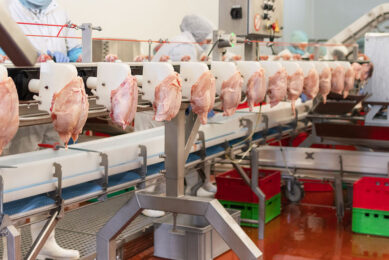Iran chicken production is up, prices soar

Iranian poultry production is bouncing back after last year’s turbulence, when production figures plummeted, owing to a crisis in the feed market.
Iranian poultry farmers delivered 191,939 tonnes of poultry to slaughterhouses in November 2023, almost 30% up compared with the previous year, the Iranian Statistical Center indicated.
Meanwhile, red meat consumption has slumped. As calculated by the Statistical Center, in November 2023, beef and veal production totalled only 19,423 tonnes, 52% lower compared with the previous month.
At the end of 2023, the average price of poultry in Iran almost reached 100,000 tomans (US$2.8) per kg, a local news outlet Mehr reported, citing official statistics. This is a substantial rise compared to 73,000 tomans (US$1.7) per kg of chicken reported in the middle of the year, the publication said.
Unreasonable growth
Ali Ebrahimi, CEO of the Iran Union of Meat and Poultry Farmers, called the price hike of the previous months “unreasonable” as it was opposite to the production dynamics.
The Iranian poultry industry experienced no major outbreaks of poultry diseases, and “even if some culls happened, they were not substantial enough” to be reflected in prices, Ebrahimi stressed, blaming sellers for the price hike, emphasising that farmers are “responsible for delivering poultry to slaughterhouses. What happens with it next is not our business.”
Lower weight
At least in some poultry farms in Iran, poultry is gaining less weight than before due to problems with feed supply, Hossein Fatemi, the former head of the National Poultry Industry Union, disclosed. He estimated that the weight of slaughtered chicken ranges between 1.8 kg and 2.5 kg, against 2.5 kg to 3 kg in the previous years.
At the end of the year, the shortage of feed inputs in Iran intensified, owing to a seasonality factor, Fatemi said, adding that traders look forward towards higher prices from the New Year and refrain from selling their stocks.
Written development plan
Over the past few years, Iranian authorities have declared ambitious goals for the domestic poultry industry. The industry, however, requires a comprehensive development programme that would be “written down”, Fatemi said.
An industry development plan is required to safeguard the industry from turbulence in the feed market in the first place. Fatemi assumed it would largely help constrain a further rise in prices.
Join 31,000+ subscribers
Subscribe to our newsletter to stay updated about all the need-to-know content in the poultry sector, three times a week. Beheer
Beheer











 WP Admin
WP Admin  Bewerk bericht
Bewerk bericht